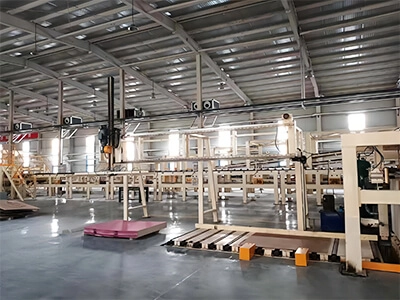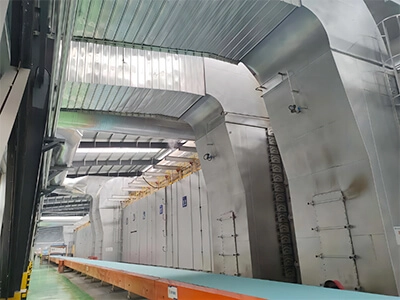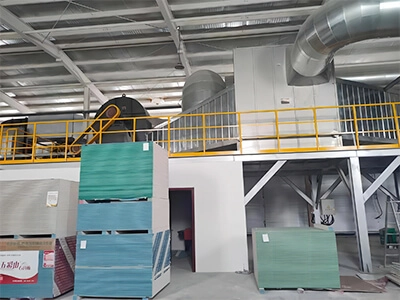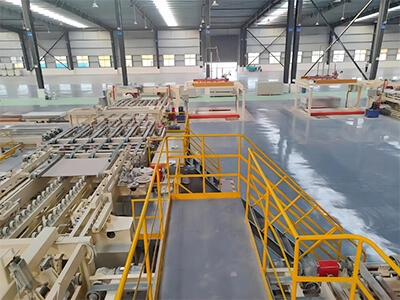
Gypsum Board Machine Factory

Paper Faced Gypsum Board Machinery

Produce Gypsum Board

Paper Faced Gypsum Board Production Line
FGD Plant is a kind of machine which is used to produce plaster from Flue Gas Desulfurization
Due to the FGD gypsum contains more than 10% of the free water after being dehydrated by the vacuum belt dewatering machine. we adopt CaSO4.2H2O pre-drying,and then be calcined by boiling furnace to produce construction gypsum powder. Using loader to take the raw materials from the raw materials yard into the hopper, after being measured , the raw material will be taken by belt conveyor to the rotary dryer to remove free water,after be collected , it will be taken to boiling furnace for calcination, after calcination ,it will be taken into the ball mill for grinding and modification, and then it will be taken to the cooked gypsum powder tank by elevator for futher use
If the flue gas desulfurization gypsum and coal powder from power plants are not treated in a timely and reasonable manner, a large area of land will be utilized, and even unnecessary secondary pollution will be brought to the environment. Desulfurization gypsum from power plants has the characteristics of high taste and small particles. However, with the widespread application of gypsum method and limestone/wet lime in thermal power plants in China, the production of desulfurization gypsum has rapidly increased due to its by-products. If the comprehensive utilization of flue gas desulfurization gypsum and powdered coal can be achieved, simply put, waste reuse will bring huge economic, social, and ecological benefits to enterprises.
The necessity of utilizing desulfurization gypsum from FGD plant.
As is well known, desulfurization gypsum is a solid pollutant discharged from power plants, also known as solid waste. If stored and discharged for a long time, it will cause serious pollution, such as air, water, and land pollution. In recent years, with the continuous development of the market economy, China is gradually developing into an industrialized city. In addition, with the increasing population in cities, people are paying more attention to the demand for electricity, and the development of thermal power plants is also increasing, resulting in an increasing amount of solid waste. The large amount of desulfurization gypsum produced by power plants not only occupies a large amount of land resources, but also contains a large amount of metal ions and alkaline oxides, which can cause serious pollution and damage to surface water bodies and ecological environment. At the same time, the power plant will spend a sum of money to build a place to store desulfurization gypsum and fly ash. Therefore, the country has put the comprehensive utilization of desulfurization gypsum in power plants on the agenda for a long time, and has successively formulated relevant preferential policies such as tax reduction and exemption. At the same time, some solid clay bricks that erode farmland, consume energy, and damage the environment have been banned from use. Local governments and units at all levels have also introduced relevant governance measures and preferential policies, ensuring the smooth implementation of the comprehensive utilization of desulfurization gypsum in power plants. Therefore, the reuse of desulfurization gypsum and fly ash resources in power plants is a constructive project related to international people's livelihood, and will be immortal. “
Research and Achievements of Desulfurization Gypsum from the FGD plant
1. Research methods; After the desulfurization gypsum raw material is taken out of the power plant's push bin, it is dried to constant weight at 45 ℃ and filtered using a 0.2mm square mesh sieve for backup. When determining the appropriate preparation process for Z, appropriate reference was made to the testing methods of GB/T9776-2008. Then, the precipitation time, calcination system, and ball milling process of desulfurization gypsum were analyzed in sequence, and the results were analyzed based on the phase and properties of building gypsum at different stages. Then, analyze and discuss the phase composition using the atmospheric pressure drying method in the three-phase analysis method.
2. Experimental results; Effect of calcination time on the performance of desulfurization gypsum
In order to explore the effect of calcination time on the performance of desulfurization gypsum, the desulfurization gypsum was calcined at 185 ℃ in the experiment. After calcination for 0.5h, 1h, 1.5h, 2h, and 2h respectively, it is aged for 7d, and then its mechanical properties, setting time, and consistency water consumption are measured. Table 2 shows the test results. painting
It can be seen that after calcination at 185 ℃ for several periods of time, the mechanical properties of desulfurization gypsum are good, and the dry compressive strength can reach 13.1MPa after 2.5 hours. It can be seen that with the continuous extension of calcination time, the dihydrate gypsum in desulfurization gypsum is more easily converted into gastrointestinal hemihydrate gypsum type. As the calcination time increases
The introduction of FGD Plant
FGD gypsum is the by-product of industrial gypsum.It is the gas desulfurization and purification which comes from the sulphur fuel (mainly coal).
At present, with the industrial development, the increase using of coal increase the emissions of sulfur dioxide into the atmosphere .The air pollution and acid rain is extremely serious. Therefore the emission of sulphur dioxide control is imperative
The most extensive and most effective sulphur dioxide control technology in the coal power plant is flue gas desulfurization, and it is the world's only large-scale commercial application of the desulfurization way currently. Flue Gas desulfurization Process can be divided into wet, semi-dry and dry three categories by technical characteristics. And its main ingredient is the same as natural gypsum,it is CaSO4.2H2O.
As a by-product of the industrial chemical gypsum, and also have the same characteristics with the other chemical gypsum : high free water, a small loose particles with a variety of impurity elements. However, as the production of Desulfurized gypsum, impurities, insoluble impurities in the mineral category, but most have no impact on the processing and application of gypsum.
In order to enhance the efficiency of flue gas desulfurization, it has much requirements onlimestone powder,calcium oxide content and the fineness of these gypsum , it guarantees the stability of the chemical constituents objectively.
Therefore, in all the chemical gypsum, because of its own higher grade (CaSO4 • 2 H2O content of up to 85 --- 95%),the desulfurized gypsum is suitable to be as raw materials in the production of building, which also has higher performance.
So , in a appropriate technology and equipment technology, desulfurized gypsum will become a cheap, high-quality, high-grade gypsum products .
Flue Gas Desulfurization Plant
How to control and improve the quality of desulfurization gypsum from the Flue Gas Desulfurization Plant ?
With the continuous deterioration of human living environment, people's awareness of environmental protection is also constantly improving. The country has also started to control pollution factors from the energy perspective and reduce environmental pollution. Coal is the main energy source in China, but coal-fired power plants produce a large amount of sulfur dioxide during the production process. In order to reduce the environmental pollution caused by the waste gas generated by coal combustion, most coal-fired power plants use desulfurization technology, which produces some by-products. This article will analyze the quality control issues of desulfurization gypsum based on the current desulfurization situation of coal in China, and provide a detailed introduction to the quality control technology of desulfurization gypsum
1. Flue Gas Desulfurization Plant technology
Flue Gas Desulfurization technology refers to the technology of reducing the amount of sulfur dioxide generated by coal combustion into the atmosphere, which can be divided into three categories: desulfurization before combustion, desulfurization during combustion, and desulfurization after combustion. Pre combustion desulfurization refers to the removal of inorganic sulfur from raw coal before coal combustion, reducing the sulfur content of coal, including physical washing coal method, chemical washing coal method, coal gasification and liquefaction, etc. Although this technology is not yet mature, pre combustion desulfurization can reduce transportation costs and recover sulfur resources. During the combustion process, desulfurization refers to the desulfurization inside the furnace. During the combustion of coal, some desulfurization agents are added, which react with sulfur dioxide to reduce the release of sulfur dioxide. Post combustion desulfurization mainly involves flue gas desulfurization, which involves adding a desulfurization device at the outlet of the combustion furnace flue to absorb the generated sulfur dioxide.
Flue gas desulfurization (FGD) can be specifically classified according to different types of desulfurization agents, including calcium method, magnesium method, sodium method, ammonia method, and organic alkali method. According to the dry and wet states of separating products and absorbing water during the desulfurization process, FGD technology is divided into wet, dry, and semi dry methods. The most widely used FGD technology is the ease of absorbent or the slurry absorbing sulfur-containing substances in a wet state. This method has the advantages of fast reaction speed, simple equipment, high desulfurization efficiency, wide and inexpensive sources of absorbent, and is suitable for various types of coal. The by-product of this method is that the desulfurization gypsum slurry can form desulfurization gypsum after dehydration, which can be recycled and reused, and has certain economic value.
2 Flue Gas Desulfurization plaster
According to the above description, Flue Gas Desulfurization is a by-product of flue gas desulfurization, which has many differences from natural gypsum. Flue Gas Desulfurization exists as separate crystalline particles. After being ground into powder, fine particles are impurities, large particles are gypsum, and natural gypsum mostly exists in blocks. After facial mask composition, fine particles are gypsum, and coarse particles are impurities, which is just the opposite of the nature of FGD gypsum. The size of desulfurization gypsum ranges from 30 microns to 60 microns, with high water content and poor fluidity. The content of various components differs greatly from natural gypsum. However, with the gradual promotion of the application of flue gas desulfurization technology in coal-fired power plants in China, the application of desulfurization gypsum has gradually received attention. It can be directly transported to cement plants as a cement retarder or supported by building gypsum powder. Its economic value is waiting for human exploration and use, and the quality of desulfurization gypsum is also gradually being valued.
Quality control of Flue Gas Desulfurization
3.1 Managing Limestone Absorbents
Absorbent is a block of limestone ground into powder, and a certain amount of water is added to prepare a slurry with a mass fraction of 10% to 15%. The finer the limestone particles, the larger the total surface area in contact with the gas, and the more sulfur containing substances absorbed. Therefore, the content of calcium oxide in limestone greatly affects the efficiency of absorbing sulfur dioxide. If the content of high and medium calcium carbonate is too high, the concentration of soluble sulfites in the circulating slurry will decrease, and the activity of limestone will decrease. Therefore, it is necessary to regularly check the content of calcium carbonate and insoluble substances in the limestone slurry. Only when the purity and fineness of limestone are reasonable, Only then can it be conducive to generating high-quality desulfurization gypsum. So relevant departments need to conduct regular testing of samples from limestone manufacturers to ensure that the content of calcium oxide in limestone powder is above 53% before it can be stored. Different prices can also be set based on the quality of limestone powder, which is beneficial for the recommended acceptance management of limestone powder and can also motivate suppliers to provide high-quality limestone powder to a certain extent.
3.2 Control of smoke and dust
Analyzing the impact of China's Flue Gas Desulfurization system on the quality of desulfurization gypsum, it can be found that many power plants in China have failed to meet the national standard for smoke and dust content. The excessive smoke and dust content makes the operation of flue gas in the absorption tower not optimistic, and the content of insoluble substances, water content, chloride ions, etc. in the generated desulfurization gypsum does not meet the standard. In addition to affecting the quality of the generated desulfurization gypsum, it will also reduce the efficiency of desulfurization, The higher the content of vehicle inspection, the lower the desulfurization efficiency. As impurities in the produced gypsum, the smoke and dust will also turn gray or even black. It is necessary to improve the dust removal system of each power plant to reduce the smoke and dust content and ensure the quality of the generated desulfurization gypsum.
3.3 Control the operating conditions of the absorption tower
Flue Gas Desulfurization is formed during the process of absorbing and burning coal generated gas in the absorption tower. The various indicators of FGD affect the quality of the generated desulfurization gypsum. The gas-liquid ratio of the absorption tower, the pH of the absorption tower slurry, the residence time of the slurry circulation in the oxidation zone, the density of the desulfurization gypsum slurry, the mass concentration of chloride ions in the absorption tower slurry, and the thickness of the gypsum filter cake must be strictly regulated, These standards can be formulated based on the current working conditions and detailed work data of the absorption towers in various coal-fired power plants. Regular inspections of the efficiency of the absorption towers will be carried out. If the absorption towers cannot meet normal indicators, the desulfurization rate will decrease, and the quality of the generated desulfurization gypsum will also be affected. Therefore, real-time monitoring of the operation of the absorption towers is necessary during the production process. The unified indicators developed are conducive to controlling the operation of the absorption tower according to detailed regulations and managing the operation of the absorption tower by relevant departments, which is conducive to generating qualified Flue Gas Desulfurization
4 Summary
Separation from gypsum can be used as a resource to replace natural gypsum. In this era where energy and resources may be scarce, manufacturers should fully utilize existing resources and create more economic benefits while reducing environmental pollution. At present, China's grasp of the application of desulfurization gypsum is not yet mature enough, and we cannot fully control the quality of desulfurization gypsum in coal-fired power plants. In the face of this situation, we should actively improve desulfurization technology, reduce the desulfurization costs invested by power plants to protect the atmospheric environment, and increase the economic benefits of power plants.